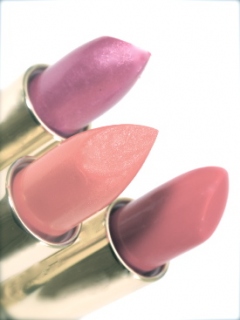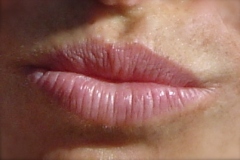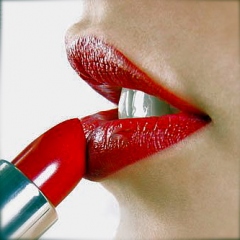Lead in Lipstick: Q + A with FDA
What every lipstick-wearer should know
Below is a quick Q + A with the FDA* about lead in lipstick. You be the judge.
Q: What is the FDA's legal authority over cosmetic safety?
A: "FDA regulates cosmetic safety under the authority of the Federal Food, Drug, and Cosmetic Act (FD&C Act). Cosmetics are not subject to pre-market approval by FDA. However, pre-market approval is required for the color additives used in cosmetics (including those in lipsticks) and other FDA-regulated products (with the exception of coal-tar hair dyes). To learn more on this subject, please refer to FDA Authority Over Cosmetics."
Q: Has the FDA set limits for lead in cosmetics?
A: "No, FDA has not set limits for contaminants, such as lead, in cosmetics. However, FDA does set specifications for impurities, such as lead, for color additives used in cosmetics. FDA approval of color additives is based on safety evaluations that consider the color additive's intended use(s) and estimated consumer exposure resulting from those uses. FDA-approved color additives are listed in Title 21 of the U.S. Code of Federal Regulations (CFR). To learn more about FDA-approved color additives, please refer to Color Additives."
Q: By the way, are color additives that contain coal-tar permitted to be used?
A: why yes, "some color additives are known as "certifiable." Certifiable color additives are man-made, derived primarily from petroleum and coal sources." (1)
Q: What are the FDA's limits for lead in color additives?
A: "FDA limits lead in color additives to no more than 20 parts per million (ppm) in cosmetics."
Q: And what is considered to be a "safe" level of lead in any product or in the human body?
A: "There is no safe level of lead in blood." (2, 3)
Q: Has FDA been aware of concerns about lead in lipstick?
A: "Yes, reports about lead in lipstick are not new."
Q: Is there a safety concern about the lead found by the FDA in lipsticks?
A: "No. FDA has assessed the potential for harm to consumers from use of lipstick containing lead at the levels found in its testing. Lipstick, as a product intended for topical use, is only ingested incidentally and in very small quantities."
Q: Forgive reiterating the question, but is lead safe to eat or is it safe in the body?
A: "There is no safe level of lead in blood" (3, 4)
Q: And of the lipsticks that have been tested by the FDA, how many of them contain lead?
A: "All of the lipsticks contained detectable amounts of (Pb) [lead]" (5)
|
FYI: Other than color additives, the FDA does not have the statutory authority under the Federal Food, Drug, and Cosmetic Act (FD&C Act) to require pre-market approval of cosmetic products such as lipsticks or their ingredients. It is the responsibility of the manufacturer or distributor to ensure that cosmetic products and their ingredients are in compliance with requirements of the FD&C Act and other applicable laws and regulations (6). With the exception of color additives, a manufacturer may use any ingredient in the formulation of a cosmetic that does not cause the cosmetic to be adulterated or misbranded under the FD&C Act. (7) |
* Q + A source: FDA (U.S. Food and Drug Administration. "Lipstick and Lead: Questions and Answers". 2009.
(1) U.S. Food and Drug Administration. "How Safe are Color Additives?". www.fda.gov/ForConsumers/ConsumerUpdates/ucm048951.htm
(2) U.S. Food and Drug Administration. Docket No. 2005D-0481 "Lead Levels in Candy Likely to be Consumed Frequently by Small Children: Recommended Maximum level and Enforcement Policy." 2006
(3) Centers for Disease Control and Prevention. "Childhood Lead Poisoning". http://ephtracking.cdc.gov/showLeadPoisoningEnv.action
(3) U.S. Food and Drug Administration. Docket No. 2005D-0481 "Lead Levels in Candy Likely to be Consumed Frequently by Small Children: Recommended Maximum level and Enforcement Policy." 2006
(4) Centers for Disease Control and Prevention. "Childhood Lead Poisoning". http://ephtracking.cdc.gov/showLeadPoisoningEnv.action
(5) Journal of Cosmetic Science. Hepp, NM, Mindak, WR, Cheng, J. "Determination of total lead in lipstick: Development and validation of a microwave-assisted digestion, inductively coupled plasma-mass spectrometric method". 60, 405-414 (July/August 2009). http://journal.scconline.org/pdf/cc2009open/cc060n04/p00405-p00414.pdf
(6) FDA (U.S. Food and Drug Administration. "Lipstick and Lead: Questions and Answers". 2009.
(7) Journal of Cosmetic Science. Hepp, NM, Mindak, WR, Cheng, J. "Determination of total lead in lipstick: Development and validation of a microwave-assisted digestion, inductively coupled plasma-mass spectrometric method". July/Aug 2009. 60, 405-414.
REFERENCES
(1) "Lead Poisoning," March 15, 2007 accessed August 2008.
(2) "Campaign for Safe Cosmetics, A Poison Kiss: The Problem of Lead in Lipstick," October 2007, accessed October 2007.
(3) R. Paige, "Dangerous Levels of Lead in Lipstick, Lip Gloss?," May 17, 2006, accessed July 2008.
(4) B. Thompson, "Is Lead Inside Lipstick," July 24, 2006, accessed September 26, 2008.
(5) Code of Federal Regulations (2008) Title 21 (U.S. Government Printing Offi ce, Washington, DC), Sections 73, 74, and 82.
(6) Federal Food, Drug, and Cosmetic Act, Chapter XI, as amended January 2004.
(7) M. Okamoto, M. Kanda, I. Matsumoto, and Y. Miya, Fast analysis of trace amounts of lead in cosmetics by atomic absorption spectrophotometry, J. Soc. Cosmet. Chem., 22, 589-598 (1971).
(8) K. D. Besecker, C. B. Rhoades, B. T. Jones, and K. W. Barnes, A simple closed-vessel nitric acid digestion method for cosmetic samples, Atom. Spectros., 19, 48-54 (1998). JOURNAL OF COSMETIC SCIENCE414
(9) Y.-H. Xu, A. Iwashita, T. Nakajima, H. Yamashita, H. Takanashi, and A. Ohki, Effect of HF addition on the microwave-assisted acid-digestion for the determination of metals in coal by inductively coupled plasma-atomic emission spectrometry, Talanta, 66, 58-64 (2005).
(10) Cosmetics, Toiletries, and Fragrances Association, "Determination of Lead Content of Finished Cosmetics and Raw Materials by Closed-Vessel Microwave Digestion Graphite Furnace Atomic Absorption Spectrometry: Lead Method CTFA 1997.DOC JAW or SLW 2001".
(11) M. Schlossman, in Handbook of Cosmetic Science and Technology, 2nd ed., Paye, Barel, and Maibach, Eds. (CRC Press, Boca Raton, FL, 2006), pp. 579-580, 588-589.
(12) L. A. Currie, Detection: International update, and some emerging dilemmas involving calibration, the blank, and multiple detection decisions, Chemomet. Intell. Lab. Syst., 37, 151-181 (1997).
(13) Geochemical Reference Standards, USGS Certifi cate of Analysis Mica Schist, SDC-1, March 1995, accessed October 2008. http://minerals.cr.usgs.gov/geo_chem_stand/mica.html





